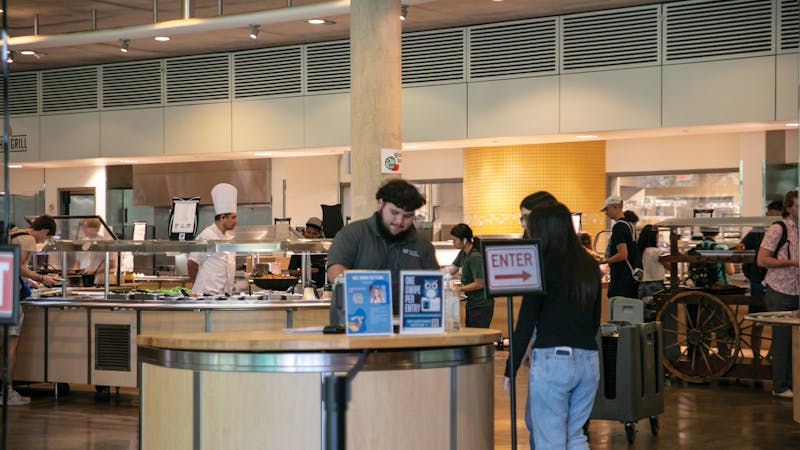Interview: Physics professor Hafner receives Hackerman Award
The Welch Foundation honored Physics Professor Jason Hafner with this year's Normann Hackerman Award in Chemistry Research. The award, named for the chemist and former Rice University president, recognizes chemical scientists in Texas beginning their careers. Hafner earned a master's degree in physics at Rice in 1996, a and has served as a faculty member at Rice for the past nine years. The Rice Thresher: What is your research background?
Jason Hafner: My background is in nanomaterials. I started in carbon nanotubes in the '90s [at Rice], looking at new ways to grow them. I looked at ways to use [nanotubes] in microscopes as field emissions sources; just various technological aspects of the tubes. I continued that in the postdoc, and of course anything dealing with nanomaterials is strongly related to chemistry.
RT: When did you first get involved with nanotechnology?
JH: I majored in physics in college and went to grad school in physics, but when I started doing research, I got drawn toward all the nano-stuff. That's just very interdisciplinary. You have to do physics and chemistry to make the materials and apply them. So academically, I've always done physics; but in research I've done a lot on the chemistry side.
RT: And what interested you in the chemistry side?
JH: I wanted to work with Rick Smalley. Also, when you go to grad school, you have to join a group, and you have lots of research groups you can go to. Of all the groups possible, that was the most interesting [to me] at the time. Nano was very new at the time . and Smalley was very persuasive and that helped talk me into it.
RT: You went to grad at Rice and came back as a faculty member. What was it that drew you to Rice?
JH: As an undergrad, I applied to a bunch of places, and I liked Rice because they got you in the lab right away. Most places you go, you're a [teaching assistant] for a year and it's heavy on the teaching. You struggle to find a lab, or maybe you don't. Rice assigned you with a group really quickly, and I knew working in a lab was my strength, more than teaching or coursework. It was a good fit for me to get in the lab right away. Coming back as a postdoc, I got an offer from Rice, and I knew I liked Rice, and I knew I liked to stay in nano, and since Rice is big in nano, it just made sense to come back.
RT: One of your research projects involves gold nanostars. Could you explain what those are and why you're studying them?
JH: That's something we discovered completely by accident. There's a famous particle called a gold nanorod, an elongated piece of gold, and we were trying to find a way to make it faster and quicker. We changed the reaction to make the material, but it's expensive to look at the material through an electron microscope. So instead, we took the optical spectrum, but it looked terrible. One of my students said, 'let's take a look at it on the [electron microscope] anyway,' and it turned out it wasn't really terrible - it was actually all these little stars that were a little bit different. The star shapes give a really complex optical spectrum. If you look at the particles all together, it's a mess. That pushed us toward doing single-particle studies.
RT: What applications do these gold nanostars have?
JH: We've used them as molecular sensors. Other people have used the many colors and angles of the stars to track their positions in three dimensions. So you can look at how they spin around inside a cell to learn more about the cell.
RT: What other topics have you been involved in researching?
JH: The other sort of thing my lab works on is something called membrane electrostatics. The idea is that there are little voltage differences in and around cell membranes that are important to what the cell membrane does. There is a little-known voltage inside the membrane called the dipole potential. It's really hard to measure, since the membrane is only five nanometers thick. We found a way to measure that voltage without touching the membrane. . Now that we can measure it, we want to see what its impact on biological functions is.
RT: What does receiving the Hackerman Award mean to you?
JH: It's a huge honor to receive an award named for Dr. Hackerman, who was a giant figure in chemistry. He was a big researcher and also very important to the university system in Texas. And especially from the Welch Foundation, who focuses on basic research, rather than applied research. Nobody thought about why we need a nanostar . we discovered a nanostar. And the dipole potential is not something a lot of people were trying to engineer into something; it's an obscure little effect that maybe has a big impact.
RT: What is your favorite part about conducting research?
JH: It's the freedom to pursue any aspect of research I want, anything I find interesting.
More from The Rice Thresher

Dis-O, move-in weekend see increase in alcohol transports from last year
Rice’s first wet weekend of the year saw four times as many calls for intoxication-related transports of students to the hospital compared to the previous three years, according to emails sent out by college presidents and chief justices.

On-campus meal plan changed to unlimited swipes
Housing and Dining recently revealed a new dining plan for the upcoming semester. The required on-campus meal plan now has unlimited meal swipes, compared to 375 meal swipes last year. H&D said the previous on-campus meal plan was for students who intended to eat on campus 15 to 25 meals a week.

Rice Stadium student section relocated
The Rice Stadium student section has been relocated to sections 106 and 107, according to an announcement from Rice Athletics on X.

Please note All comments are eligible for publication by The Rice Thresher.